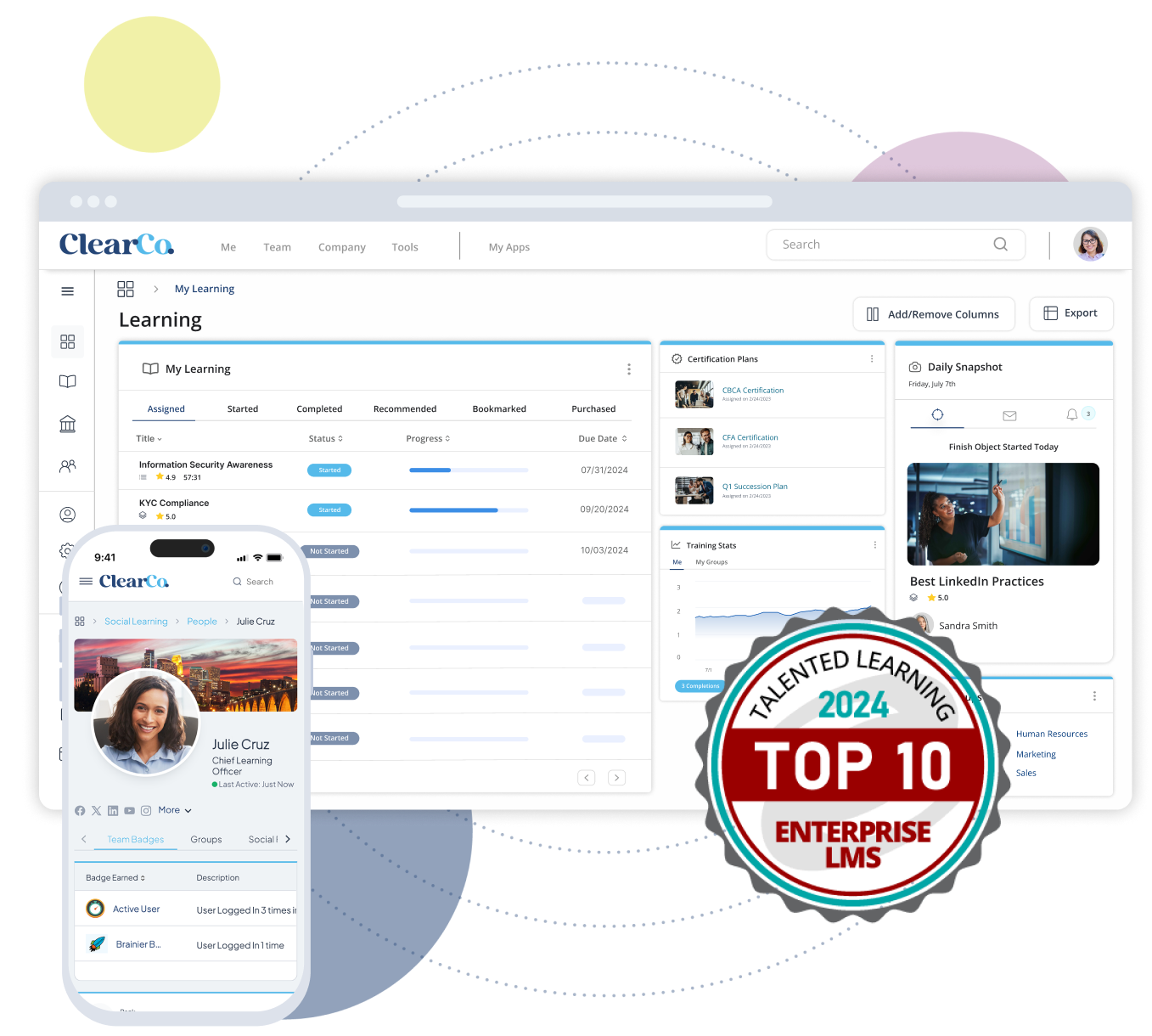There’s never been a better time to invest in your people, specifically in your employee training programs, than now, in “the decade of upskilling.” New technologies, like artificial intelligence (AI), require new, up-to-date expertise. The skills gap — the difference between the skills companies need and those their employees have — continues to widen. That’s put many of us in a “skills crisis,” with 49% of learning and development (L&D) leaders concerned that their workforce is lacking essential skills.
If you’re one of them, there’s still time to turn the tide with employee training programs. When your program incorporates a variety of training types, you can offer well-timed, practical, and engaging training courses that meet the needs of your learners. You can help employees develop real, valuable skills and envision their long-term future at your organization.
Let’s take a look at the different types of training programs, when to use them, and their benefits. We’ll also talk about the difference between training and L&D. Then, we’ll share a few tips on how to create your own training program.
What Are Employee Training Programs?
Employee training programs consist of structured training sessions or courses designed to teach specific skills or processes. The courses usually require employees to complete competency tests or other assessments to ensure they retain the knowledge.
Employee training and development are often used interchangeably, and both typically fall under a company’s L&D umbrella. But they refer to different types of learning experiences:
- Employee training is targeted and job-specific, designed to help employees gain a particular skill or piece of knowledge relevant to their role. Training programs are typically structured the same for every employee, though there may be flexibility in course format. Employee training includes compliance training, technical skills training, and safety training.
- Employee development refers to learning opportunities that help your people grow in their careers. Professional development initiatives, like career coaching, mentoring programs, and leadership skills training, help employees strengthen weak areas, become eligible for promotions, and earn recognition. Improving employee development programs can complement more effective training programs.
Training programs address more immediate needs at a business, while L&D programs are more personalized and designed to support continuous growth. Both types of employee learning opportunities are invaluable, contributing to higher engagement, retention, and productivity.
10 Types of Employee Training Programs
Developing different employee training systems for every stage and level equips L&D teams with a robust toolkit to keep the workforce up-to-date, increase agility, and maintain a competitive edge. These programs help new hires get up to speed fast, train longtime employees on updated procedures, comply with changing laws, and more.
Does your company offer any of these training programs?
1. Onboarding or New Hire Training
Onboarding training programs introduce new hires to your company’s culture, policies, and procedures. They equip new employees with the role-specific tools and knowledge they need to do their best and achieve their goals, creating a solid foundation for their long-term success.
The first few weeks at a new job are nerve-wracking. Onboarding training puts new hires’ nerves at ease, providing clear direction and helping them feel confident and connected from day one.
2. Skills-Based Training
Skills-based training teaches employees the technical or job-specific skills necessary to excel in their roles. Whether it’s mastering new software, learning industry best practices, or refining an advanced technique, this type of training gives employees the support they need to perform at their best.
Skills-based training keeps competencies sharp and up-to-date. It’s good for individual performance and for helping your company stay agile and competitive.
3. Soft Skills Training
Soft skills training develops essential interpersonal abilities, like communication, teamwork, problem-solving, and emotional intelligence. These skills are the glue that holds teams together, fostering collaboration, improving relationships, and creating a more productive and harmonious work environment. It’s becoming increasingly harder to find candidates with soft skills — all the more reason to invest in this training.
4. Compliance Training
Compliance training ensures employees understand and follow the laws, regulations, and policies that apply to your organization. Common topics like workplace safety, anti-harassment, and data privacy help protect both employees and the company from potential risks.
This training isn’t just about checking a box. It’s about creating an ethical and safe workplace culture and a legally compliant environment where everyone can thrive.
5. Diversity, Equity, and Inclusion (DEI) Training
DEI training helps employees build awareness and understanding of diversity in the workplace. It covers topics like unconscious bias, cultural competency, and inclusive practices, empowering employees to create a more respectful and equitable environment. By fostering inclusivity, DEI training strengthens team dynamics, promotes collaboration, and ensures everyone feels valued and supported.
6. Safety Training
Safety training teaches employees how to identify and prevent workplace hazards and teaches them everyday safety procedures as well as emergency responses. It’s especially critical in industries like construction, manufacturing, and healthcare, where safety risks are higher. Safety training protects your employees from harm and reinforces the idea that safety is everyone’s responsibility and an integral part of your work culture.
7. Customer Service Training
Customer service training prepares employees to deliver high-quality customer experiences. It focuses on areas like active listening, conflict resolution, and empathy, as well as the processes they’ll follow to take call notes and complete support tickets. This training ensures employees can handle the logistics of their role, like how to complete proper documentation and when to escalate complaints. It also gives them tools to handle any situation with professionalism and care.
8. Management Training
Management training prepares leaders to guide their teams effectively. Your program may train them in skills like delegation, performance management, and decision-making to help them better support their employees and drive results. Strong leadership is the foundation of a high-performing team, and this training ensures managers are ready to rise to the challenge.
9. Product or Service Training
Product or service training gives employees a deep understanding of what your company offers. It’s especially important for those in sales, marketing, and customer support roles, where employees need to effectively communicate value to customers. When employees know your products and services inside and out, they can confidently answer questions, solve problems, and showcase what makes your company stand out.
Product or service training isn’t one-and-done — it’s necessary for new hires and throughout employees’ tenure when products are updated or services change.
10. Sales Training
Sales training develops the skills that enable employees to close deals and build strong client relationships. Training topics include prospecting, negotiation, and handling objections — critical skills for helping sales teams meet their targets. With the right training, your sales team can turn leads into loyal customers and drive revenue growth for your business.
How to Develop an Effective Employee Training Program
Creating a training program that delivers results requires careful planning and execution. Follow these steps to build an employee training system that works:
1. Know Your Company’s Needs
Start by defining your organization’s goals and identifying skill gaps. This ensures your training program addresses the areas that matter most. It also helps make a stronger case for investing in these programs.
2. Define Clear Learning Objectives
Set specific, measurable goals for what employees should achieve by the end of the training. Clear objectives keep the program focused and effective.
Imagine your manufacturing plant installed new machinery. In order to learn how to operate it, the team of employees needs to progress through a series of training sessions. Your program ensures that they don’t move up to the next session until they’ve mastered the previous skill.
3. Offer Appropriate Training Methods
Does the training subject matter require in-person training, or can employees take online-based learning courses? Annual anti-harassment training can be completed effectively online, but learning how to use new machinery more than likely requires in-person training. Choose methods that align with your objectives and audience, whether it’s interactive live workshops, e-learning, or on-the-job training.
4. Choose the Right Learning Management System (LMS)
Employee training software like an LMS makes everything easier, from AI-enhanced content creation to reporting on the results. An LMS streamlines the delivery, tracking, and management of your training program. Look for a system that’s user-friendly, regularly updated, and flexible.
5. Create Engaging Learning Content
Create content that’s interactive, relevant, and easy to understand. Engaging materials keep employees motivated and improve knowledge retention. With an LMS, you can offer different training materials — from videos to quizzes to gamification — that appeal to every learner.
6. Measure Effectiveness and Adapt
One of the most important parts of running a successful training program is tracking employee training success. You need to know if your program is actually working or if your people are struggling with it. Your LMS makes it easy, helping you understand which types of training courses are most popular, if they’re actually improving productivity, where employees are getting stuck or dropping out of courses, and more.
When you know what works and what doesn’t, you can make changes that actually help make training more effective. For example, imagine you find that an online course isn’t helping employees remember safety procedures. So, you switch to a hybrid course that includes in-person training sessions to ensure a safe work environment.
Build Your Employee Training Program with ClearCompany Learning
Developing an effective training program doesn’t have to be overwhelming. ClearCompany Learning makes it easy to create, deliver, and manage online training programs that drive results.
Ready to get started? ClearCompany’s L&D AI Prompt Templates can help you get better responses from your AI tools and build a custom training program — fast.
Download the L&D AI Prompt Templates now and take the first step toward building a training program that empowers your employees and drives success.


